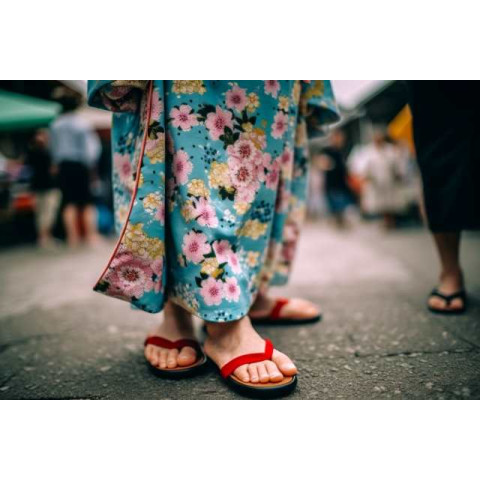
Japanese traditional shoes for wearing a kimono are called "zori" or "geta." These shoes not only complement the elegance of the kimono but also have functional aspects that make them suitable for various occasions.
Zori are flat, thonged sandals that are often made with lacquered soles and fabric straps. They are generally more delicate and formal in appearance, often worn with more formal kimono ensembles such as for tea ceremonies, weddings, or other special events. Zori comes in a wide variety of styles, colours, and materials, allowing women to choose a pair that matches the colours and patterns of their kimono.
Geta, on the other hand, are elevated wooden sandals with two horizontal wooden supports (dai) underneath. They are held onto the foot with fabric straps, similar to zori. Geta are known for their distinctive "clacking" sound when walking, and they are commonly seen in both casual and semi-formal settings. Geta provides some elevation, which helps keep the hem of the kimono off the ground, protecting it from dirt and wear. They are often worn with yukata, a lighter and more casual type of kimono, for festivals, summer outings, and other relaxed occasions.
Both zori and geta have their unique charm and serve as essential accessories to complete the traditional look of wearing a kimono.
Here are some ideas for wearing Zori or Geta in casual ways these days.
Yukata or Casual Kimono: When wearing a yukata or casual kimono, pairing them with zori or geta can create a relaxed and authentic look suitable for events like summer festivals or casual outings.
Coordination: Choose zori or geta that complements the colours of your outfit. Neutral colours like black, white, or natural wood tones are versatile and can match many outfits.
Socks: Tabi socks, which have a separation between the big toe and the rest of the toes, are commonly worn with zori or geta. However, for casual wear in warmer weather, you can go without them.
Comfort: Ensure that the zori or geta fit well and are comfortable to walk in. Geta with a lower platform is easier to walk in for those who are not accustomed to them.
Embrace the Experience: Wearing traditional Japanese footwear is a chance to immerse yourself in the culture and create unique experiences. Approach it with respect and an open attitude.

Leave a Comment